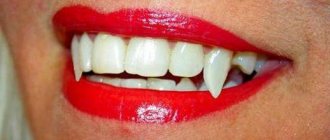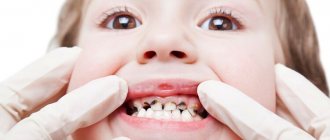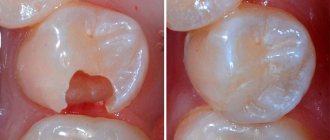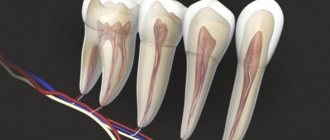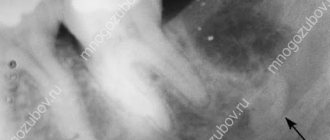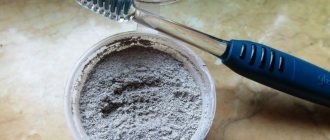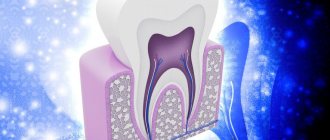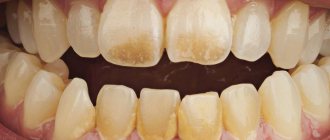Probably one of the most terrible pains a person can experience is toothache. When a tooth hurts, it is almost impossible to endure, and then even the most ardent dentist-hater goes to “surrender” to the doctor. But not everyone knows why teeth hurt and how to avoid these unpleasant sensations. Together with the dentist-therapist of the StilDent clinic, Elena Gennadievna ZIBNITSKAYA, we will look at the most common causes of toothache.
The most common causes of toothache are caries, pulpitis, periodontitis and pericoronitis.
Caries
This is a disease of the hard tissues of the tooth, leading to the destruction of enamel and dentin. First of all, caries affects the natural depressions on the teeth (fissures), as well as areas where plaque accumulates in large quantities - these are the interdental spaces and the gingival area. With caries, the hard tissues of the tooth demineralize and soften, and subsequently a defect in the form of a cavity forms on the tooth.
Caries has several stages, the process can be initial, superficial, medium and deep. At first, caries is almost asymptomatic - the main inconvenience that a person experiences is associated with food getting stuck in carious cavities. Another symptom of caries, which is usually not paid much attention to, is short-term pain from chemical, mechanical, and temperature irritants. Simply put, damaged enamel no longer protects the tooth from the effects of hot tea or ice water or from mechanical stress, and at this moment we experience pain. But because it only lasts a few seconds, we usually don't take it seriously.
When the process reaches the last stage - deep caries, the unpleasant sensations become difficult to ignore. With deep caries, the patient experiences pain when food and liquid enter the damaged area, pain when brushing teeth (irritation from paste and brushes), pain from any external irritants, temperature, chemical, mechanical. Once the irritant is removed, the pain subsides until the next episode. At this stage, the quality of life is already significantly reduced. But if a person continues to stubbornly endure and does not go to the doctor, the nerve of the tooth (pulp) is gradually involved in the inflammatory process, and pulpitis begins.
What to do?
It is almost impossible to cure the root cause at home. You can only temporarily dull the pain on your own. There are several effective ways to do this. Please note that the methods listed are only a temporary solution to the problem:
- Medicinal painkillers. The surest way to wait until you see the doctor is to take a pain reliever. Nimesulide, Nise or Ketarol tablets are suitable for this purpose. As a last resort, if there is nothing suitable at home, you can take Paracetamol. This remedy is not as effective against pain, but it has an anti-inflammatory effect.
- Ethnoscience. Make a decoction based on medicinal herbs, for example, chamomile or sage will do. Rinse your mouth every three hours. You can also use alcohol tincture of propolis. Add a couple of drops of the product to a glass of warm water, rinse your mouth 4-5 times a day for at least 5 minutes.
- Antiseptic treatment. Use Chlorhexidine or Miramistin according to the instructions. The destruction of pathogenic microorganisms sometimes leads to temporary relief, for example, when it comes to caries.
Pulpitis
This is an inflammation of the pulp (nerve) of the tooth, the process is usually accompanied by acute pain. Pulpitis occurs as a reaction to constant exposure to irritants that enter the pulp through a carious cavity, as well as due to the influence of microorganisms and toxins on the nerve of the tooth. Irritation of the pulp leads to a change in blood flow, which provokes increased pressure on the nerve fibers.
At the initial stage, pulpitis manifests itself as mild pain, which goes away when the irritant is removed. At this stage, the inflammation goes away on its own if the irritant is removed - that is, caries is cured and the tooth is filled, isolating the pulp from external influences.
If you do nothing, the inflammation gradually intensifies and the pain increases. The stage of acute pulpitis begins, irreversible changes occur in the pulp. Pain is easily caused by any irritant. The “don’t eat, don’t drink, keep your mouth closed” option doesn’t save you from pain. Very often, toothache worsens at night.
Pain in acute pulpitis can be very different:
- Sharp or blunt
- Pulsating or constant
- Localized or spilled
- Short or long term
If you continue to ignore your condition and do not consult a dentist, then the next stage is complications that are likely to develop with acute pulpitis, including purulent pulpitis.
Diseases of internal organs and toothache
The exact cause of pain can only be determined during an examination - dental or comprehensive. However, experienced doctors know about the relationship between painful or uncomfortable sensations in the mouth and pathologies of internal organs. If pain is localized in one or another part of the jaw, the doctor may suspect certain diseases of the kidneys, spleen, stomach, etc. Of course, one symptom is not enough to make a diagnosis, but there may be a reason for additional examination.
Toothaches and changes in internal organs can be correlated as follows:
- Respiratory tract diseases (pneumonia, polyps, bronchitis) and intestinal dysfunction cause pain in the premolar area.
- Pathologies of the genitourinary system are sometimes accompanied by pain in the front teeth - incisors.
- Malfunctions of the spleen, stomach or excretory system are transmitted to the molars.
- The cardiovascular system is closely related to the “eights” - wisdom teeth.
- If the fang hurts for no obvious reason, it is worth checking the bile ducts.
- If tartar forms, you can be examined for diseases of the endocrine system.
Many people immediately take painkillers when they experience toothache or other pain. Today, quite strong drugs are produced that can relieve almost any pain, but they only eliminate the symptom. The disease itself and its causes cannot be cured with analgesics. If the etiology of toothache is not established, it will progress further. As a result, the risk of complications increases. If you have a toothache or other unpleasant symptoms in the oral cavity, immediately make an appointment with your dentist.
Chronic pulpitis
In the most patient patients, acute pulpitis can become chronic. The pain becomes less acute and constant, sometimes subsides for a long time. If the carious cavity is difficult to access by irritants, chronic pulpitis can be almost painless.
Symptoms of chronic pulpitis
- Pain in the cold
- Pain when eating hot food
- Pain during temperature changes (for example, when you leave the house on a cold street)
- Prolonged aching pain if the carious cavity is clogged with food debris
Chronic pulpitis can worsen at any time and give you all the unforgettable sensations of acute pulpitis.
If chronic pulpitis is not treated, it can develop into periodontitis.
How to speed up the rehabilitation process
Main rules of behavior after the procedure:
- refuse hot/cold, sour, spicy, too hard foods for the next 3 hours;
- in the first two days, limit yourself to lukewarm soft foods;
- remove dyes – natural and synthetic – from your diet for the next couple of days if you do not want your teeth to change color;
- focus on foods high in calcium and magnesium;
- use a soft-bristled brush until the discomfort goes away;
- do not use paste containing more than 50 RDA of abrasives;
- Take complex vitamins regularly; you can additionally drink calcium and magnesium;
These recommendations will help you reduce the time during which your teeth hurt after whitening and enjoy a Hollywood smile.
Acute periodontitis
Periodontitis is an inflammatory process in periodontal (periodontal) tissues in the area of the apex of the tooth root. Often, inflammation involves the cementum and dentin of the tooth root, as well as the alveolar bone. Periodontitis in most cases occurs due to damage to the pulp, that is, pulpitis.
Symptoms
- The pain is constant, throbbing, with clear localization
- The pain intensifies from any touch to the tooth, including when chewing
- Pain may spread to part of the face
- Headache
- General weakness
- Temperature increase
- Cheek swelling
- Pain in the gum, redness and swelling in it
- Submandibular and chin lymph nodes are enlarged
- Possible discharge of pus from the root canal
Diagnosis for toothache
First, the dentist will conduct a visual examination of your mouth. Usually, to identify caries, if it does not develop on the tooth root or under the gum, the doctor simply needs to examine the diseased tooth. In some cases, he uses special indicators that color the areas of enamel affected by the carious process blue or purple. The doctor may also prescribe radiography, laser diagnostics, electroodontometry and transillumination. If dental pathologies are excluded, you will need to go to other specialists - an otolaryngologist, a surgeon, a neurologist or a therapist.
Chronic periodontitis
Chronic periodontitis sometimes develops asymptomatically, or acute periodontitis can progress to this stage. Chronic periodontitis develops when the pulp dies, and favorable conditions are created in the tooth for the development of microorganisms. Sometimes chronic periodontitis can appear after a tooth injury.
Symptoms
- Changing the color of tooth enamel
- The presence of a fistula on the gum
- Painful sensations when chewing solid food
Chronic periodontitis can have many very serious complications: granuloma, root cyst, pathological fracture of the lower jaw, periapical abscess, phlegmon and others.
How long does pain last?
How many days do teeth hurt after whitening is the second most popular question after the cost of the service. Everything is individual and depends on the state of health and characteristics of the human body.
When lightening is carried out correctly, the discomfort goes away immediately after the procedure - as soon as the active composition is removed from the tooth surface. But with increased sensitivity of the enamel, it can last for a short time.
The discomfort completely disappears on the second or third day. In some cases, the period may extend to 5-10 days.
How long teeth hurt after whitening is also influenced by the patient’s behavior. It is important to follow the doctor’s recommendations to speed up the recovery process and avoid consequences.
Pericoronitis
This is difficult eruption of wisdom teeth (eights). When a tooth cannot erupt normally, inflammation of the surrounding soft tissue and periosteum behind the dental socket begins. Inflamed gums are constantly injured when chewing, which further aggravates the process.
The inflammatory process can gradually lead to the development of purulent pericoronitis.
Symptoms:
- Constant pain that gets worse when chewing
- Pain radiates to the ear and temporal region
- Pain when opening the mouth
- Enlargement and tenderness in the submandibular lymph nodes
- Sharp pain when pressing on the gums, purulent discharge is possible
- Increased body temperature
In the future, the pain continues to intensify and the body temperature rises. The patient's health deteriorates significantly, and retromolar periostitis may develop.
Why does enamel wear off?
Minor deformations do not lead to the development of hyperesthesia, but the longer the disease develops, the more painful the consequences. Common reasons why enamel wears off:
- calcium absorption disorders;
- poor nutrition;
- genetic disorders;
- pathology of the thyroid gland.
There may also be congenital defects that lead to a thinning of the protective layer with age. The cause may be bad habits, increased consumption of fiber-depleting drinks, and smoking tobacco. The process can be affected by improper treatment, contact of the crown with the walls of the teeth, incorrect installation of the prosthesis or braces.
Having found out the reason why the enamel on the teeth is worn away, the doctor can choose a treatment. The patient may notice changes before pain appears. Discomfort appears when eating cold, hot, or sweet foods. Sensitivity gradually increases, roughness and thinning appear. The surface darkens and characteristic layers form.
